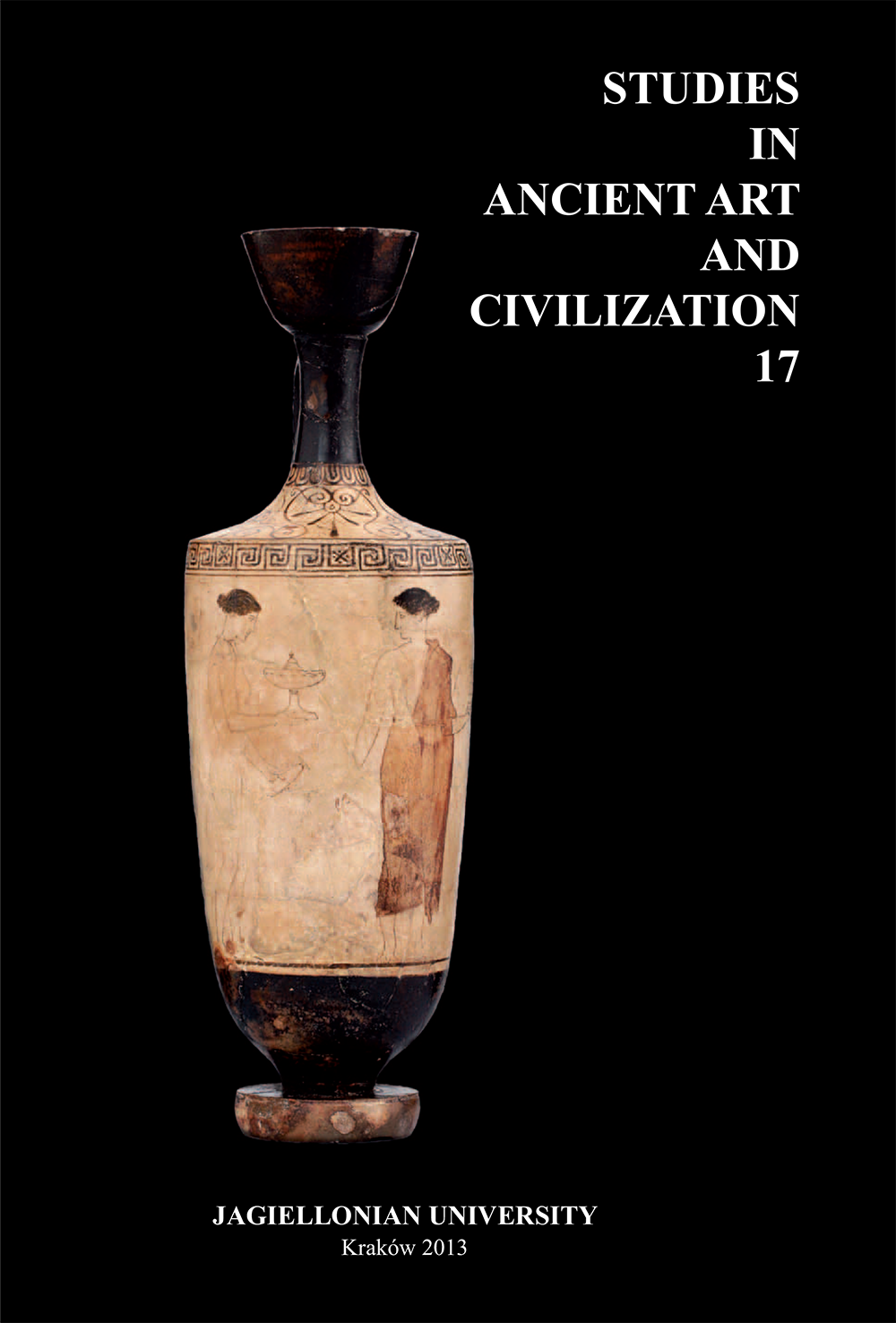More on the Labyrinth on the Coins of Knossos
DOI:
https://doi.org/10.12797/SAAC.17.2013.17.11Keywords:
Crete, Knossos, coinage, labyrinth, Minos, MinotaurAbstract
In his ‘Natural History’ (36.84-93), Pliny the Elder lists four buildings termed ‘labyrinths’. His second labyrinth, which came directly after the Egyptian one, was built by Daedalus in Crete, not far from Knossos, and appears on Knossian coins as the symbol of Knossos. The main aim of this article is to discuss the differing forms of this labyrinth and their origins. The first coins of Knossos appeared around 470 BC and bore a pattern of four meanders to indicate a labyrinth. A square labyrinth pattern followed and this was finally replaced by one of circular form.
References
Andreev Yu. A. 2002. Ot Evrazii k Evrope. Kriti Ègejskij mir v èpohu bronzy i rannego železa (III-načalo I tys. do n.è.). St Petersburg.
Armstrong E. A. 1943. The crane dance in East and West. Antiquity 66, 71-76. DOI: https://doi.org/10.1017/S0003598X00017920
Bartonĕk A. 1983. Zlaté Mykény. Prague.
Brugsch H. 1872. Das altägyptisches “Seeland”. ZÄS 10, 89-91. DOI: https://doi.org/10.1524/zaes.1872.10.112.89
Cavanagh W. G. and Curtis M. (eds) 1998. Post Minoan Crete. Proceedings of the First Colloquium on Post-Minoan Crete held by the British School at Athens and the Institute of Archaeology, University College London, 10-11 November 1995. (British School at Athens Studies 2). London.
Coldstream J. N. 1998. Minos redivivus: some nostalgic Knossians of the ninth century BC (a summary). In W. G. Cavanagh and M. Curtis (eds), 58-61.
Connor W. R. 1970. Theseus in Classical Athens. In A. G. Ward (ed.), 143-174.
Cook A. B. 1914. Zeus. A Study in Ancient Religion 1. Cambridge.
Daszewski W. A. 1977. Nea Paphos 2. La mosaïque de Thésée. Études sur les mosaïques avec représentations du Labyrinthe, de Thésée et du Minotaure. Warsaw.
Edwards R. B. 1970. The growth of the legend. In A. G. Ward (ed.), 25-50.
Elderkin G. W. 1910. Notes on Greek vase paintings. Part 1: Meander or labyrinth. AJA 14, 185-190. DOI: https://doi.org/10.2307/496828
Graham J. W. 1957. The Central court as the Minoan Bull Ring. AJA 61/3, 255-262. DOI: https://doi.org/10.2307/500728
Graham J. W. 1972. The Palaces of Crete. Princeton.
Hall M. R. 1905. The two labyrinths. JHS 25, 320-337. DOI: https://doi.org/10.2307/624244
Heller J. L. 1961. A labyrinth from Pylos? AJA 65/1, 57-62. DOI: https://doi.org/10.2307/502503
Hess Nachfolger A. 1918. Sammlung griechischer Münzen. Frankfurt am Main.
Hirsch J. 1907. Auctions-Catalog 18. Munich.
Hutchinson R. W. 1962. Prehistoric Crete. Harmondsworth.
Huxley G. L. 1971. Crete in Aristotle’s Politics. GRBS 12, 505-515.
Kerényi K. 2002. Mitologia Greków, transl. by R. Reszke. Warsaw.
Kraay C. M. 1976. Archaic and Classical Greek Coins. Berkeley, Los Angeles.
Lang M. 1958. The Palace of Nestor excavations of 1957, part 2. AJA 62/2, 181-191. DOI: https://doi.org/10.2307/502353
Le Rider G. 1966. Monnaies crétoises, du Ve au Ier siècle av. J.-C. Paris. MacDonald D. 1996. Mercenaries and the movement of silver to Crete in the late fourth century B.C. NomChron 15, 41-47.
Mørkholm O. 1991. Early Hellenistic Coinage from the Accession of Alexander to the Peace of Apamea (336-188 B.C.). Cambridge.
Naerebout F. G. 1997. Attractive Performances. Ancient Greek Dance: Three Preliminary Studies. Amsterdam.
Naville & Cie 1925. Monnaies grecques et romaines, Naville & Cie. Genève.
Nichols M. 1975. Man, Myth, and Monument. New York.
Press L. 1964. Labirynt. Archeologia 15, 31-42. DOI: https://doi.org/10.1021/cen-v042n015.p031
Press L. 1967. Architektura w ikonografii przedgreckiej. Wrocław, Warsaw, Krakow.
Press L. 1972. Życie codzienne na Krecie w państwie króla Minosa. Warsaw.
Press L. 1973. On the origin of Minoan palatial architecture. Archeologia 24, 1-11.
Riechmann A. & Co. 1924. Auktions. Katalog 30. Halle.
Rouse N. W. 1901. The double axe and the labyrinth. JHS 21, 268-274. DOI: https://doi.org/10.2307/623875
Santarcangeli P. 1982. Księga labiryntu. Warsaw.
Sippel D. V. 1987. The Cretan ‘labyrinth’ on the coinage of Knossos. SAN Journal of the Society for Ancient Numismatics 17/2, 32-35.
SNG Copenhagen 1982. SNG The Royal Collection of Coins and Medals Danish National Museum. Vol. 3: Greece: Thessaly to Aegean Islands. West Milford.
Souza Ph. de 1998. Late Hellenistic Crete and the Roman conquest. In W. G. Cavanagh and M. Curtis (eds), 112-116.
Stefanakis M. I. 1999. The introduction of coinage in Crete and the beginning of local minting. In A. Chaniotis (ed.), From Minoan Farmers to Roman Traders. Sidelights on the Economy of Ancient Crete, 247-268. Stuttgart.
Stefanakis M. I. 2000a. Kydon the Oikist or Zeus Cretagenes Hynotraphes? The problem of interpreting Cretan coin types. Ευλιμένη 1, 79-90.
Stefanakīs M. I. 2000b. Στεφανάκης Μ. І. 2000. Στην «Λαβύρινθος» της Μεσαράς. Corpus 42, 49-54.
Stieglitz R. R. 1981. Labyrinth: Anatolian axe or Egyptian edifice? Ιn L. Casson and M. Price (eds), Coins, Culture and History in the Ancient World. Numismatic and Other Studies in Honor of Bluma L. Trell, 195-198. Detroit.
Svoronos J.-N. 1890. Numismatique de la Crète ancienne. Macon.
Svoronos I. 1894. Sur la signification des types monétaires des anciens. BCH 18, 101-128. DOI: https://doi.org/10.3406/bch.1894.3678
Tidworth S. 1970. The Roman and Medieval Theseus. In A. G. Ward (ed.), 175-194.
Ward A. G. (ed.) 1970. The Quest for Theseus. London.
Weber K.-W. 1974. Troiae Lusus. Alter und Entstehung eines Reiterspiels. Ancient Society 5, 171-196.
Willets R. F. 1965. Ancient Crete: a Social History from Early Times to the Roman Occupation, London, Toronto.
Willets R. F. 1977. The Civilization of Ancient Crete. Berkeley, Los Angeles. DOI: https://doi.org/10.1525/9780520333543






